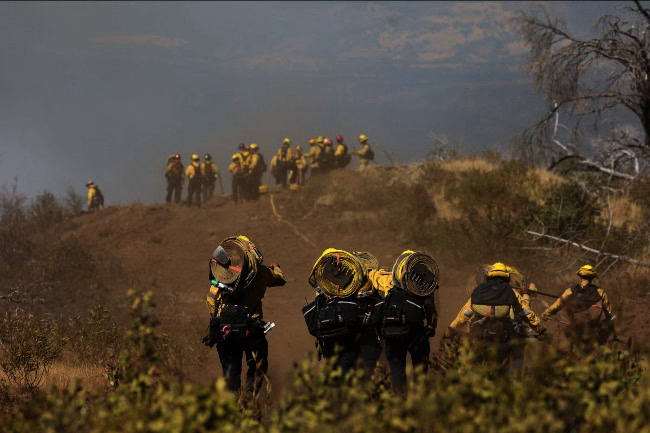
At the direction of Gov. Gavin Newsom, the California Governor’s Office of Emergency Services and Cal Fire continue to preposition resources and respond aggressively to new fires.
California Governor’s Office of Emergency Services, or Cal OES, predeployed firefighting resources and personnel to 12 counties in anticipation of critical fire weather that started last Wednesday and will continue to persist through today.
Since Aug. 22 there have been over 74,000 lightning strikes in the state of California with over 33,000 strikes happening just in the last 24 hours.
The National Weather Service forecasts critical fire weather for Tuesday and Wednesday due to abundant lightning and gusty winds that will increase fire spread.
Officials said this will affect the Inland Region, including Sacramento Valley and mountain ranges.
In addition, portions of the Southern and Inland regions of the state may be under a flood watch due to threats of heavy rainfall.
Despite extreme heat, widespread red flag warnings, and thousands of lightning strikes recorded across the state, California kept numerous new wildfires small and manageable, with most being quickly extinguished within the first 24 hours.
The state has deployed 2,700-plus personnel, 14 helicopters, 248 engines, 75 dozers and 29 water tenders to the Pickett Fire in Napa County — helping stop its forward growth and ramp up containment.
“California continues to be in a readiness posture for extreme heat and fire weather. Our aggressive response to this weather and our predeployment strategy has meant that only a handful of the more than 200 new fire starts have grown past 10 acres. We continue to have thousands of personnel deployed across the state to keep communities safe,” said Newsom.
For more than one week, high temperatures, low humidity and dry lightning were present throughout the state. California took action by predeploying available resources to communities that could be impacted by severe fire weather.
Local fire agencies identify when conditions in their community may require additional resources and submit a request to the state for support.
A total of 78 fire engines, 20 water tenders, nine bulldozers, five helicopters, 10 hand crews, 16 dispatchers, and two Incident Management Teams were approved for 12 counties, including Inyo, Kern, Los Angeles, San Bernardino, San Diego, Santa Barbara, Ventura, Sierra, Nevada, Plumas, Placer, Calaveras, and Trinity.
Staging locations and response assignments are coordinated by local officials.
These efforts ensure that resources are ready to respond quickly, minimizing the potential impact of new fires.
Officials said this proactive approach has proven to be a critical component of California’s wildfire response strategy, reducing response times and containing fires before they escalate into potential major incidents.
The preposition program is in addition to California’s Fire and Rescue Mutual Aid System, which remains available for emergency response support throughout the state where resources are needed.
At the governor’s direction, the State Operations Center at Cal OES remains on an “enhanced watch” status for both heat and fire conditions.
Cal Fire responds quickly during fire weather conditions
Since Aug. 21, California has seen more than 200 new fire starts, with 132 of those within Cal Fire's jurisdiction.
Thanks to an aggressive initial attack strategy and strong mutual aid system, only a handful of these fires grew to over 10 acres. Officials call this a “remarkable success rate” that’s a testament to the dedication and preparedness of the state’s firefighters.
In anticipation of the predicted fire weather conditions, Cal Fire bolstered resources by pre-positioning crews and equipment in Southern California.
In Northern California, Incident Management Team four was assigned to the Pickett Fire in Napa County, supporting the Cal Fire Sonoma-Lake-Napa Unit in combating this quickly spreading fire in a highly populated area.
This strategy of aggressively attacking all fires has proven incredibly effective. By achieving containment quickly, communities face less disruption and worry, and more resources are available for the next new fire starts. This swift and decisive initial attack strategy will continue as challenging conditions persist into the fall.
Residents are urged to stay vigilant during heightened heat and fire weather. Californians are reminded to:
• Prepare a wildfire action plan, including planning evacuation routes and packing a go-bag with essentials.
• Sign up for local emergency alerts to stay informed about changing conditions.
• Visit CalHeatScore.CalEPA.ca.gov to find heat safety information specific to your area.
For more information on fire safety and general preparedness, visit Ready.ca.gov.

 How to resolve AdBlock issue?
How to resolve AdBlock issue? 



